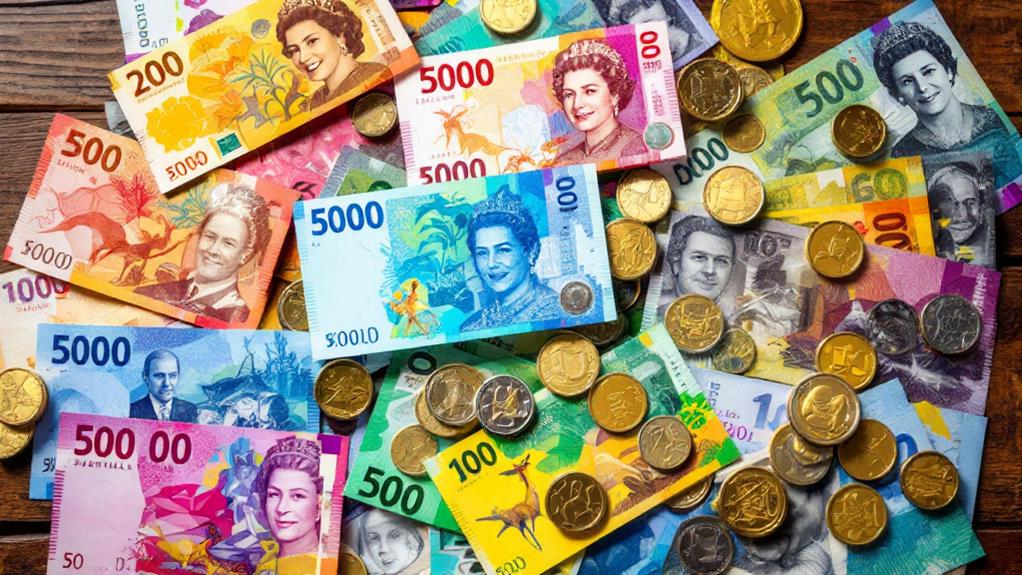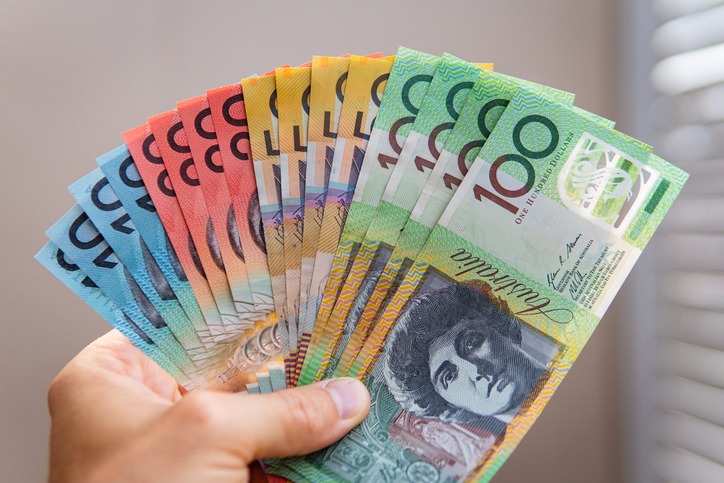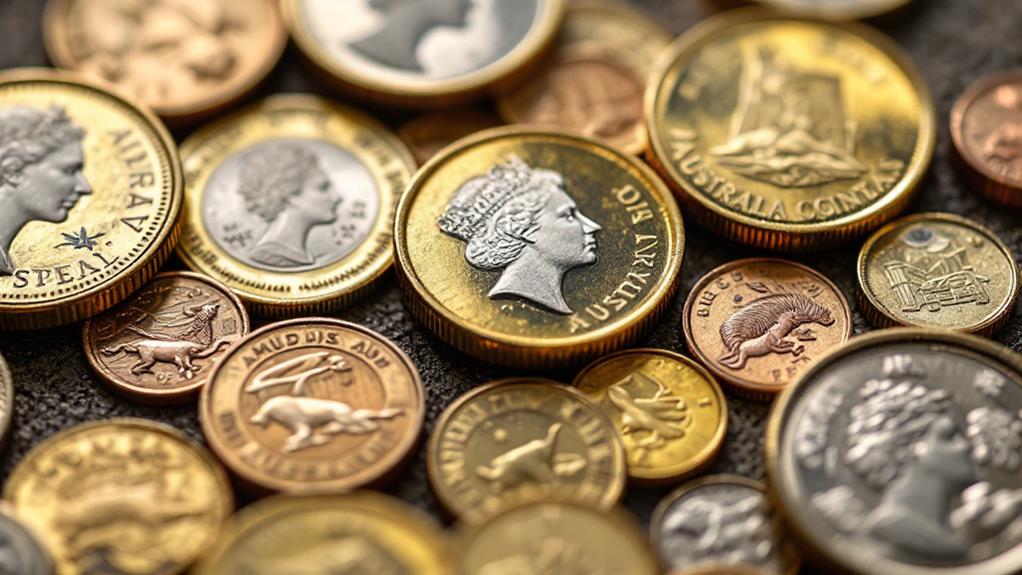What Money Does Australia Use? A Guide to the Australian Dollar

In Australia, you'll use the Australian Dollar (AUD), introduced in 1966. This currency replaced the Australian pound, aiming to simplify transactions with its decimal system. You'll find coins in denominations from 5 cents to 2 dollars, crafted for durability. Paper banknotes ranging from $5 to $100 are made from polymer, incorporating advanced security features. The AUD serves as a significant global currency and plays a key role in international finance. ATM access is widespread, and major credit cards like MasterCard and Visa are widely accepted. There's more to uncover about its impact and features.
Overview of the Australian Dollar
Australia's currency, the Australian dollar (AUD), has a rich history since its introduction on February 14, 1966, when it replaced the Australian pound. Today, the Australian dollar stands as a key player on the global stage, being the seventh most-held reserve currency. This stability and liquidity make it a significant part of international finance. The Australian currency is subdivided into 100 cents and comes in durable polymer banknotes, ranging from $5 to $100 in denominations, ensuring security and longevity.
In terms of exchange rates, the Australian dollar has seen its ups and downs over the years. Its highest recorded value against the US dollar was $1.1080 on July 27, 2011. As of the fourth quarter of 2023, the exchange rate hovers around $1.00 AUD to $0.67 USD. This fluctuation is influenced by numerous economic factors, including monetary policies set by the Reserve Bank of Australia, which plays a vital role in managing the Australian economy.
When you look at the Australian dollar symbol, you'll notice it's denoted as $, A$, or AU$ to distinguish it from other currencies. This makes it easier to identify in international transactions.
History and Adoption

Many might not know that the Australian dollar's voyage began on February 14, 1966, when it replaced the Australian pound. This significant shift marked Australia's changeover from a monetary system tied to the British pound to its own national currency, the Australian dollar. The Australian pound had been in use since 1910, pegged to the British currency, but the idea of a decimal currency started gaining traction in the late 1950s.
In 1959, a committee was formed to investigate the benefits and logistics of adopting a decimal system, which eventually led to the introduction of the Australian dollar. The goal was simple: streamline the monetary system by moving from pounds, shillings, and pence to a more straightforward structure where 1 dollar equals 100 cents. This change not only simplified financial transactions but also modernized Australia's financial framework.
The Australian dollar quickly gained traction, and today, it stands as the fifth-most-traded currency globally. Its introduction marked a crucial moment in the history of the Australian national currency, solidifying its role in international finance and trade, and allowing Australia to carve its own path in the global economy.
Coinage Specifications

The Australian dollar features a varied range of coin denominations, carefully designed to facilitate everyday transactions. You'll find coins in values of 5 cents, 10 cents, 20 cents, 50 cents, along with $1 and $2 coins. These denominations guarantee that you can handle different payment scenarios with ease. The 5 cents, 10 cents, and 20 cents coins are primarily composed of nickel and copper, providing durability for frequent use. Meanwhile, the $1 and $2 coins stand out with their aluminum bronze composition, making them both lightweight and robust for daily transactions.
A unique aspect of the Australian coinage is the 50 cent coin, which is distinct with its 12-sided shape. This feature not only differentiates it visually but also makes it easily recognizable among other coins. Although 1 cent and 2 cent coins were once part of the monetary system, they were discontinued in 1991 due to rising production costs and decreased usage. Despite their discontinuation, these coins remain legal tender, but their usage is now limited to transactions not exceeding 20 cents. Understanding these specifications helps you appreciate the practicality and design of Australian currency in everyday life.
Banknote Features
Take a closer look at the distinct features of Australian banknotes, as they stand out for their durability and security. Made from polymer, these banknotes were initially introduced in 1988, offering a significant advantage over traditional paper notes. Not only do they last longer, but they also incorporate sophisticated security features that make counterfeiting a tough challenge.
The Reserve Bank of Australia guarantees each banknote meets strict quality standards. Here's what you'll find when you examine these banknotes:
- Transparent windows: Each note includes transparent sections that are hard to replicate, enhancing security.
- Holographic images: These images shift when you tilt the note, making it difficult for counterfeiters to reproduce.
- Color-shifting ink: The ink changes color when viewed from different angles, adding another layer of protection.
- Indigenous imagery: The recently redesigned $5 note celebrates Australian culture with indigenous designs.
The denominations of Australian banknotes are $5, $10, $20, $50, and $100, each showcasing cultural and historical figures. The colors of these notes—blue, red, yellow, green, and purple respectively—make them easy to distinguish. Australian banknotes not only reflect the nation's heritage but also set a global standard for security and innovation.
Exchange Rate Trends

Over the years, the Australian dollar's progression has been a rollercoaster, with notable highs and lows that reflect its dynamic nature. Since its float in 1983, the Australian dollar (AUD) has experienced considerable fluctuations. For instance, it reached an impressive peak of $1.1080 USD in July 2011, while hitting a low of 47.75 USD cents in April 2001. Such volatility is largely due to its status as a commodity currency, where shifts in commodity prices greatly influence its value. These natural resources play a vital role in determining the exchange rate, making the AUD sensitive to global economic changes.
As of Q4 2023, the exchange rate stood at approximately $1.00 USD to $1.57 AUD, suggesting the US dollar's strength against the Australian dollar. Currently, the AUD/USD trading range fluctuates between $0.63 to $0.68 USD. This range reflects ongoing global economic conditions and underscores the AUD's position as the sixth-most-traded currency in the foreign exchange market. The AUD/USD pair accounts for about 5% of forex trades, highlighting its significance in international commerce. Keeping an eye on commodity prices and global economic trends can help you navigate these exchange rate shifts.
Legal Tender Guidelines
Australia's lively currency system, with its colorful notes and shiny coins, forms the backbone of daily transactions. The Australian dollar (AUD) serves as the official legal tender across the nation, with notes available in denominations of $5, $10, $20, $50, and $100, and coins in 5, 10, 20, 50 cents, along with $1 and $2. Understanding how legal tender works here can simplify your transactions.
Legal tender laws set certain guidelines:
- The Reserve Bank of Australia oversees the issuance and regulation of both coins and banknotes, guaranteeing only authorized production.
- Coins, including the 50-cent piece, are legal for payments up to specific limits.
- For instance, 1c and 2c coins are legal tender only for amounts not exceeding 20c.
- The Currency Act 1965 governs these laws, which reflect the evolving nature of currency regulations.
While the Reserve Bank Act 1959 allows for unlimited issuance of notes, the Currency Act imposes limits on coin usage in transactions. These rules keep the currency practical and efficient for everyone. Understanding these guidelines guarantees you're using the Australian dollar correctly, making your financial interactions smooth and hassle-free.
International Usage

The Australian dollar (AUD) is more than just a currency; it's an vital player on the international stage. Not only is it the official currency in Australia and its territories, but it's also legal tender in several Pacific nations like Kiribati, Nauru, and Tuvalu. You'll find the AUD widely accepted in these regions for everyday transactions, making it a significant part of the local economies.
The AUD's influence extends far beyond these areas. Globally, it's the fifth-most-traded currency, accounting for about 6.8% of daily foreign exchange turnover. This high trading volume reflects its strategic importance in international finance. You might not realize it, but the AUD's value is closely tied to trade relations, especially with Asia. Australia's export of natural resources and commodities plays a substantial role in shaping its exchange rates.
In the global financial arena, the AUD ranks as the seventh most-held reserve currency as of Q4 2023. This status underscores its reliability and importance in international finance and trade. Regardless if you're a traveler or a businessperson, understanding the Australian dollar's role on the world stage is vital for maneuvering international markets effectively.
Credit Card Use
When traveling in Australia, you'll find that credit cards are frequently accepted across the country, with MasterCard and Visa being the most commonly used. Diners Club is also widely recognized in many locations, while American Express has more limited acceptance. Discover cards, however, are generally not accepted in Australia.
To make your trip smoother, keep these tips in mind:
- International transaction fees: These typically range from 1% to 3% for credit card purchases, so be sure to check with your card issuer about specific charges.
- Debit card use: Consider using a debit card for purchases, as they often have lower fees than credit cards.
- ATM access: ATMs are readily available for cash withdrawals using your credit card, but be aware of potential fees.
- Inform your bank: Let your bank know about your travel plans to avoid unexpected card holds, ensuring uninterrupted access to your funds.
In terms of currency, all transactions with your credit card will be converted to the Australian dollar. This can sometimes lead to higher costs due to varying exchange rates and fees. It's always wise to confirm these details with your bank before departure to manage any unexpected expenses.
Banking and ATM Access

Maneuvering the banking and ATM landscape in Australia is straightforward, thanks to the widespread availability of ATMs and reliable banking services. The Australian dollar (AUD) is the official currency, and you can access it easily through numerous ATMs in both urban and rural areas. Major banks like NAB, ANZ, Commonwealth Bank, and Westpac offer extensive banking services, including currency exchange and ATM access, making it convenient to manage your finances.
Using debit and credit cards is common, but to avoid any hiccups, it's best to inform your bank about your travel plans. This prevents potential holds on your cards, ensuring smooth international card transactions. While ATMs provide a hassle-free way to withdraw cash in AUD without the need for currency exchange at banks or exchange bureaus, keep in mind that they typically charge fees for international card transactions. To minimize these costs, look for ATMs that belong to your bank's partner network.




